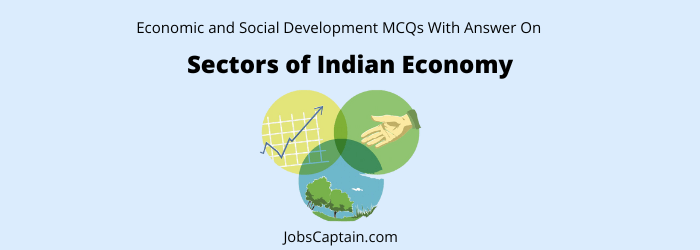
| Quiz | 1 | 2 | 3 |
| Return To | Economic and Social Development MCQ | ||
Question 1: The prices at which the government purchases grains for maintaining public distribution system and for building up buffer-stock is known as __________.
(A) Minimum Support Prices
(B) Procurement Prices
(C) Issue Prices
(D) Ceiling Price
Question 2: Indian agriculture has the following features.
- Dependence of agriculture on the monsoons
- Abolition of zamindari
- Absence of trade unions in the agricultural sector
- Heavy pressure of population on land
Which of the above is responsible for disguised unemployment in agriculture?
(A) Only 1
(B) Only 1 and 2
(C) 1, 2 and 3
(D) Only 4
Question 3: India disguised unemployment is found in ____________.
(A) Agricultural Sector
(B) Industrial Sector
(C) Service Sector
(D) Trade Sector
Question 4: In India, which of the following have the highest share in the disbursement of credit to agriculture and allied activities?
(A) Commercial Banks
(B) Micro Finance Institution
(C) Regional Rural Banks
(D) Co-operative Banks
Question 5: Which among the following is providing least institutional credit to agriculture and allied activities in recent years?
(A) Commercial Banks
(B) Foreign Private Banks
(C) Co-operative Banks
(D) Regional Rural Banks
Question 6: Following are the source of institutional credit to agriculture in India.
- Co-operative Banks
- Regional Rural Banks
- Commercial Banks
Which one is the correct sequence in descending order of their importance?
(A) 1, 3, 2
(B) 2, 1, 3
(C) 3, 2,1
(D) 3, 1, 2
Question 7: Green Revolution made the country self-sufficient in food production, but had some fallouts. Consider the following statements.
- It is successful in case of wheat, but not in the case pulses.
- Brought inter-state disparities.
- Help in restoring soil fertility.
- Reduced water table in some states.
Select the correct statements from the codes given below.
(A) 1, 2 and 4
(B) Only 2 and 4
(C) 1, 3 and 4
(D) All are correct
Question 8: What is/are the recent policy initiative(s) of government of India to promote the growth of manufacturing sector?
- Setting up of National Investment and manufacturing Zones.
- Providing the benefits of ‘single window clearance’.
- Establishing the technology acquisition and development fund.
Select the correct answer using the codes given below.
(A) Only 1
(B) 2 and 3
(C) 1 and 3
(D) 1, 2 and 3
Question 9: Which of the following is included in National Food Security Mission (NFSM)?
(A) Wheat
(B) Pulses
(C) Rice
(D) All of the above
Question 10: Since 1997-98 which statement is correct regarding Minimum Support Price (MSP)?
(A) MSP = C2 costs
(B) MSP > C2 costs
(C) MSP < C2 costs
(D) MSP is independent to C2 cost
Question 11: Among the following, which one is related to Blue Revolution in India?
(A) Floriculture
(B) Sericulture
(C) Pisciculture
(D) Horticulture
Question 12: NAFED is connected with _________.
(A) Animal husbandary
(B) Conservation of fuel
(C) Agricultural marketing
(D) Agricultural implements
Question 13: Public Distribution System is aimed at ___________.
(A) providing food security to the poor
(B) to prevent hoarding and black marketing
(C) to prevent overcharging by traders
(D) All of the above
Question 14: Some time back, the Government of India, decided to delicense ‘White goods industry’. White
goods includes __________.
(A) stainless steel and aluminium utensils
(B) milk and milk products
(C) items purchased for conspicuous consumption
(D) soaps, detergents and other mass consumption goods
Question 15: Consider the following statements. Small-Scale industries are in most cases not as efficient and competitive as the large-scale ones. Yet the Government provides preferential treatment and reservation in a range of products to the small firms because small scale-industries.
- Provide higher employment on per unit capital development basis.
- Promote a regional dispersion of industries and economic activities.
- Have performed better in export of manufactured products than the large scale ones.
- Provide jobs to low skill workers who otherwise may not find employment avenues else where.
Which of the above statements are correct?
(A) 1 and 4
(B) 1 and 2
(C) 2 and 3
(D) 3 and 4
Question 16: Small Scale and Cottage Industries are important because _____________.
(A) they provide more employment
(B) Government helps them
(C) they are traditional
(D) management is easy
Question 17: Which one of the following is the objective of National Renewal Fund?
(A)To safeguard the interests of who may be affected by technological upgradation of industry or closure of sick units
(B) To develop core sectors of the economy
(C) For the development ofinfrastructure such as energy, transport, communications and irrigation
(D) For human resource development such as full literacy, employment, population control, housing and drinking water
Question 18: Consider the following factors regarding industry.
- Capital investment
- Business turnover
- Labour force
- Power consumption
Which of these determine the nature and size of the industry?
(A) 1, 3 and 4
(B) 1, 2 and 4
(C) 2, 3 and 4
(D) 2 and 3
Question 19: Which one of the following committees recommended the abolition of reservation of items for the Small Scale Sectors in industry?
(A) Abid Hussain Committee
(B) Narsimhan Committee
(C) Nayak Committee
(D) Rakesh Mohan Committee
Question 20: The Meera Seth Committee was concerned with __________.
(A) development of handlooms
(B) gender bias in employment
(C) the abolition of the child labour
(D) the welfare of the working women
Question 21: Which one of the following is not the problem of Small Scale Industries (SSIS)?
(A) Finances
(B) Marketing
(C) Raw material
(D) Strikes and lockouts
Question 22: The Concept of ‘Navratna’ is associated with ____________.
(A) selected categories of technical manpower
(B) selected export – oriented units
(C) selected food – processing industries
(D) selected Public Sector Enterprises
| Quiz | 1 | 2 | 3 |
| Return To | Economic and Social Development MCQ | ||
